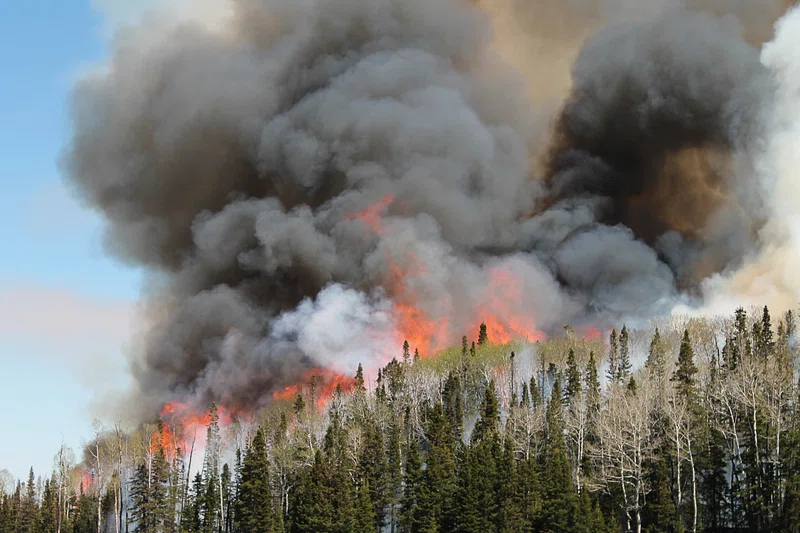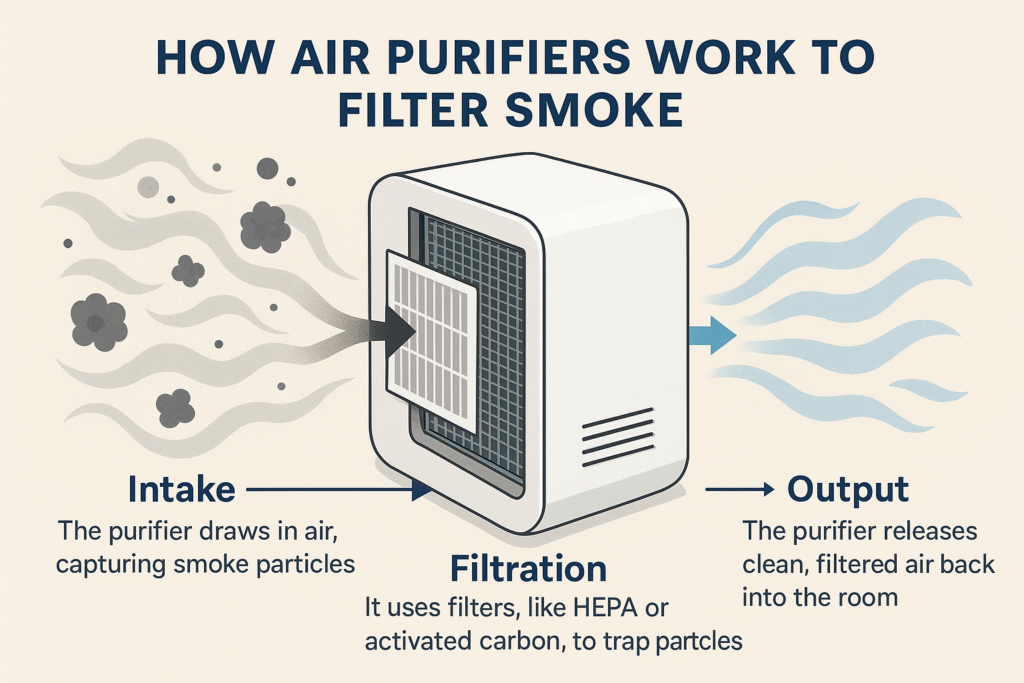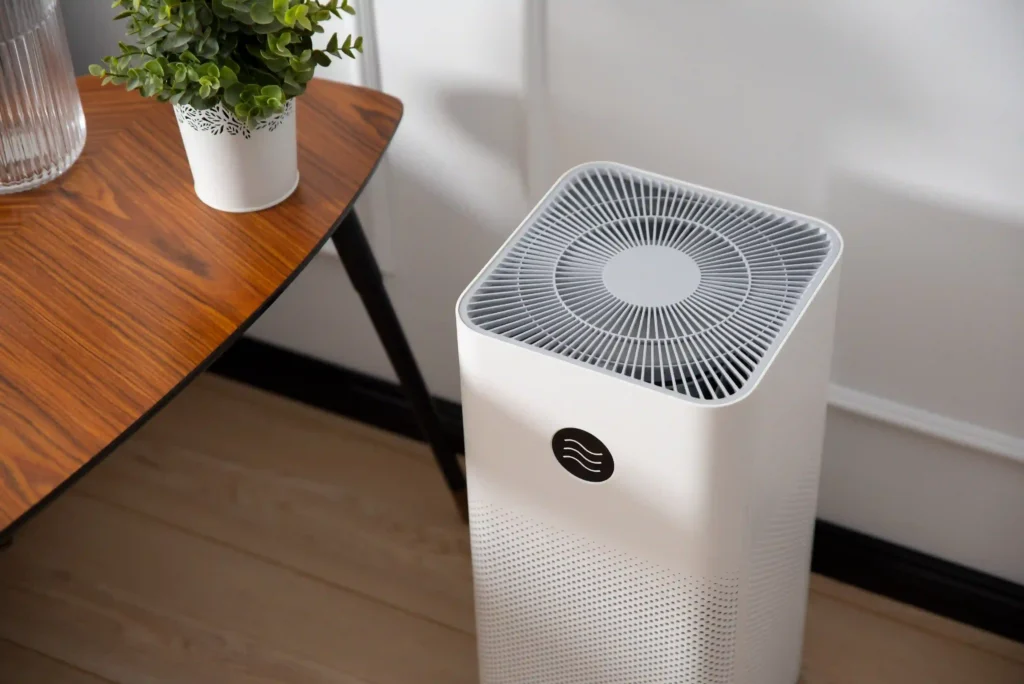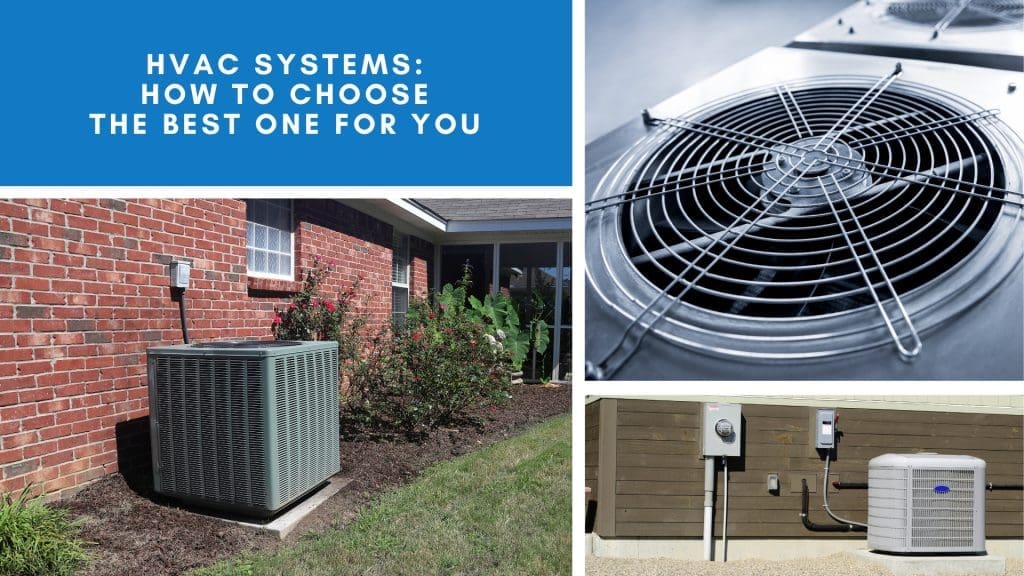Wildfires are a common occurrence, especially in areas like Los Angeles. They can cause significant damage to property and the environment. But have you ever thought about the impact of wildfire smoke on your indoor air quality?
Wildfire smoke is a complex mixture of gases and fine particles. These particles can infiltrate your home, affecting the air you breathe. This can be a concern for everyone, but especially for those with respiratory conditions, the elderly, and children.

So, what can you do to protect your indoor air quality during a wildfire event?
One solution is an air purifier. But does an air purifier help with wildfire smoke? That’s the question we’ll be addressing in this comprehensive guide.
We’ll delve into the science behind air purifiers and how they work to filter smoke. We’ll discuss the types of filters used in air purifiers, such as HEPA and activated carbon filters. We’ll also explain the role of the Clean Air Delivery Rate (CADR) in determining an air purifier’s effectiveness.
Choosing the right air purifier for smoke can be a daunting task. There are many factors to consider, including the size of your room and the specific features of the air purifier. We’ll guide you through this process, providing practical tips and advice.
We’ll also share real-life examples and testimonials of how air purifiers have helped during wildfires. These stories can provide valuable insights into the benefits of air purifiers in improving indoor air quality.
In addition to using an air purifier, there are other measures you can take to protect your indoor air quality during a wildfire event. We’ll discuss these measures, such as sealing your home and monitoring air quality.
Finally, for small business owners, we’ll provide tips on how to market air purifiers and ensure customer satisfaction. Educating your customers on the benefits of air purifiers and providing quality service and support can build trust and grow your business.
So, whether you’re a small business owner, a work-from-home professional, or a stay-at-home mom, this guide is for you. Let’s explore the world of air purifiers and their role in combating wildfire smoke.
Understanding Wildfire Smoke and Its Impact on Indoor Air Quality
When wildfires occur, they unleash a cocktail of smoke and gases into the air. This smoke doesn’t just linger outside; it often infiltrates homes and workplaces.
You might wonder how this smoke affects your indoor air quality. Let’s dive into the components of wildfire smoke that contribute to poor air quality indoors.
The Composition of Wildfire Smoke
Wildfire smoke is a blend of many harmful components. It includes fine particles, called PM2.5, which can penetrate deep into your lungs.
This smoke also contains toxic gases and chemicals. Volatile organic compounds (VOCs), carbon monoxide, and formaldehyde are notable examples.
These pollutants originate from the burning of vegetation, buildings, and other materials. They can compromise your air quality and pose serious health risks.
How Wildfire Smoke Affects Health
Breathing in smoke can have immediate health effects. For some, it leads to eye irritation, coughing, or difficulty breathing.
Long-term exposure might worsen existing health conditions. Those with heart or lung disease, asthma, and children are particularly vulnerable.
It’s crucial to keep indoor air as clean as possible during wildfire events. That’s where understanding smoke impact and measures comes in.
The Travel of Wildfire Smoke: Altadena and Eaton Fires
Wildfire smoke can travel great distances. Even areas far from the fire source can experience elevated pollution levels.
Take the Altadena and Eaton fires as examples. They affected air quality in regions far from the original blaze.
Residents experienced smoke odors and reduced visibility. Their homes, workplaces, and schools weren’t immune to smoke infiltration.
The travel of smoke emphasizes the importance of having a robust indoor air quality strategy. Understanding the full impact of smoke can help prepare us for these events, ensuring our safety and health.
The Science Behind Air Purifiers and Smoke
Air purifiers offer a reliable solution to improve indoor air quality during smoke events. Understanding their science can help you choose the best option.
At the heart of air purifiers, you’ll find different types of filters. Each plays a unique role in removing pollutants from the air.
Most air purifiers use a combination of physical and chemical processes. They target both particles and gases present in smoke.
For those affected by wildfire smoke, a good air purifier can be a game-changer. It helps maintain a safer and more comfortable living space.
How Air Purifiers Work to Filter Smoke
Air purifiers function by drawing in polluted air and passing it through various filters. Once trapped inside, particles and gases are removed.
Here’s a simple breakdown of how air purifiers tackle smoke:
- Intake: The purifier draws in air, capturing smoke particles.
- Filtration: It uses filters, like HEPA or activated carbon, to trap particles and absorb gases.
- Output: The purifier releases clean, filtered air back into the room.

These steps make purifiers effective against smoke pollutants. They offer cleaner air, helping reduce the health effects linked to smoke exposure.
Types of Filters: HEPA and Activated Carbon
HEPA (High-Efficiency Particulate Air) filters are critical in combating smoke. They capture up to 99.97% of particles, including smoke PM2.5.
Beyond particles, smoke carries odors and chemicals. Here’s where activated carbon filters come into play.
Activated carbon can adsorb odors and VOCs, like formaldehyde. By doing so, it effectively neutralizes the smell and chemical presence of smoke.
These filters work together to fight both the physical particles and chemical compounds found in smoke.
The Role of CADR in Air Purifier Effectiveness
The CADR (Clean Air Delivery Rate) measures an air purifier’s efficiency. It tells you how fast the purifier can clean air in a specific room size.
Higher CADR values signify faster and more effective smoke removal. This makes it a crucial factor when selecting an air purifier for smoke.
Remember, matching the CADR to your room size ensures optimal performance. It guarantees that your space is adequately purified, maintaining better air quality.
Selecting the Right Air Purifier for Smoke
Choosing the right air purifier is essential for tackling smoke in your home. You’ll want the best fit to meet your specific needs.
First, evaluate the room size. Ensure the purifier can handle your space effectively. This ensures the air is cleaned efficiently.
Next, consider the features. Some purifiers offer additional benefits like smart sensors or UV-C lights. These can enhance functionality.
Cost is another important factor. Consider the initial price and ongoing filter replacements. Balance cost with effectiveness.
Finally, read reviews and check certifications like Energy Star. These can guide you to trusted, high-quality models.

Room Size and Air Purifier Capacity
Matching your air purifier to your room size is key. This ensures the purifier works effectively.
When considering capacity, check the CADR rating. It should suit your room dimensions for best results.
A small air purifier won’t effectively clean a large room. Conversely, a large purifier may be unnecessary in a small space.
Use the manufacturer’s guidance on room size compatibility. This helps avoid under- or over-capacity choices.
Features to Look for in an Air Purifier for Smoke
Different air purifiers come with a range of features. Choose ones that best fit your needs.
Consider the following key features:
- HEPA Filters: For trapping fine particles.
- Activated Carbon Filters: To absorb smoke odors and chemicals.
- Smart Sensors: These adjust filtration based on smoke levels.
- Noise Levels: A quieter model can improve comfort.
- Energy Efficiency: Saves energy and reduces costs.
These features offer tailored solutions for smoke, enhancing your air quality.
Air Purifier Maintenance for Optimal Performance
Maintaining your air purifier is crucial. Regular maintenance keeps it performing at its best.
Check and replace filters as needed. This ensures efficiency in tackling smoke.
Keep the unit clean. Dust and debris can hinder performance.
Here’s a simple maintenance checklist:
- Check Filters: Replace every 6-12 months, or as required.
- Wipe Surfaces: Clean the exterior weekly to prevent dust buildup.
- Inspect Intake/Output Areas: Ensure airflow is not obstructed.
Consistent care ensures your purifier continues working effectively. It prolongs its lifespan and keeps your air fresh.
Real-Life Benefits: Air Purifiers and Wildfire Smoke
Air purifiers can be lifesavers during wildfire season. They significantly improve indoor air quality. Many households can attest to their effectiveness.
Imagine your home filled with smoky haze from nearby wildfires. An air purifier can transform that environment. The result? Breathing easier and cleaner air.
During wildfires, the air can be thick with harmful particles. Many have found relief using the right air purifier. This makes living in such conditions much more bearable.
Air purifiers don’t just clean the air; they also protect health. Those with respiratory issues experience noticeable improvements. Even homes far from wildfires are affected by drifting smoke.
For those living in wildfire-prone areas, air purifiers provide peace of mind. Knowing your family breathes clean air is comforting. Let’s explore some specific examples.
How Air Purifiers Helped During Wildfires
In recent wildfire events, air purifiers proved invaluable. Consider the Altadena and Eaton fire incidents. Both caused widespread smoke that affected indoor air.
During the Altadena fire, residents invested in air purifiers. Many reported immediate relief from smoke particles. This proactive step reduced health risks significantly.
Nearby, the Eaton fire presented a similar challenge. Again, air purifiers played a crucial role. Families who used them experienced less respiratory discomfort.
These highlight the importance of air purifiers. They show how effective these devices can be in real-world scenarios. Clean air is achievable even amidst wildfire chaos.
Testimonials: Personal Stories of Improved Air Quality
Real people have shared stories of air purifiers changing their lives. Parents, for instance, have noticed a difference in their children’s health. Kids breathe easier and experience fewer allergy symptoms.
A work-from-home professional recounted her struggle during fire season. Her productivity dropped due to smoke entering her home. With an air purifier, she found clarity and could work efficiently again.
One stay-at-home mom was worried about her family’s safety. After investing in an air purifier, she felt reassured. She noticed the air smelled fresher and looked cleaner.
These personal accounts underscore the value of air purifiers. They go beyond just reducing smoke—they improve quality of life. Clean indoor air is essential for health and comfort.
Additional Measures to Improve Indoor Air Quality During Wildfire Events
When wildfires rage, maintaining clean indoor air is crucial. Air purifiers play an important role, but they’re not the only solution. Combined with other strategies, they work even better.
To ensure the best air quality, consider these methods alongside your purifier. They’ll help you breathe easy during challenging times. Let’s explore a few effective strategies.
Sealing Homes and Monitoring Air Quality
Start by sealing your home tightly. Check windows and doors for drafts. Use weather stripping and door sweeps to minimize air leaks.
Sealing reduces the entry of outdoor smoke. It helps your air purifier work more efficiently by cutting down the volume of pollutants it needs to remove.
Monitoring air quality is equally important. Use indoor air quality monitors to track improvements. These monitors provide insight into pollutant levels, helping you take timely action.
By sealing your home and monitoring air quality, you gain control. Your environment becomes a safe haven from outdoor smoke. This proactive approach is key during smoke events.
Creating a Clean Room with an Air Purifier
Designate a clean room in your home for ultimate protection. Choose a space you frequent, like the living room or a bedroom. This creates a safe area for family members to gather during smoke alerts.
Equip this room with a high-efficiency air purifier. The device will concentrate its effort where it’s most needed. Keep the door closed to maintain air purity.
In this clean room, escape smoke exposure. It’s your indoor retreat from outdoor pollutants. With the right setup, your home remains a sanctuary, even when outside air is hazardous.
Marketing and Customer Satisfaction: Tips for Small Business Owners
Successful marketing is key to small business growth, especially in niche markets like air purifiers. Educating your customers on the benefits of air purifiers is crucial. It builds awareness and sparks interest.
Focusing on the specific needs of your audience can boost your marketing strategy. Tailor your message to highlight how air purifiers solve real problems. For instance, address concerns about health during wildfire seasons.
Creating a list of key features and benefits can make your message clear:
- Reduces exposure to harmful pollutants
- Alleviates respiratory symptoms
- Enhances indoor air quality
- Provides peace of mind
Addressing these elements not only informs but can also persuade potential customers. They need to see value in your products for their specific situations.
Lastly, leverage testimonials and customer feedback. Real-life stories resonate well. They help potential buyers see tangible benefits and make informed decisions.
Educating Customers on Air Purifier Benefits
Education empowers customers. It’s vital to present facts about air purifiers clearly and concisely. Understanding the science behind air purification can guide buyers to the right product.
Start by explaining how air purifiers combat common pollutants. Detail how they capture smoke particles and vocs, neutralizing odors and chemicals. This knowledge allows customers to appreciate the technology’s impact.
Highlight the health benefits of clean air, especially during wildfires. Explain how reducing airborne pollutants can improve respiratory health and overall comfort.
Use various platforms to educate your audience. Blogs, social media, and informational brochures each play a role. These resources can position your business as a trustworthy expert in air quality solutions.
Building Trust Through Quality Service and Support
Trust is the foundation of customer relationships. Providing quality service and support ensures satisfaction and loyalty. It also sets your business apart from competitors.
Respond promptly to customer inquiries. Whether answering questions or resolving issues, quick and courteous communication matters. It demonstrates your commitment to their needs.
Offer a comprehensive support package. This could include installation guides, maintenance tips, and troubleshooting assistance. By making information accessible, you empower customers to get the most from their purchase.
Encourage feedback and reviews. They offer insights into customer satisfaction and areas for improvement. Listening to customer experiences can guide your service improvements and foster a community around your brand.
Conclusion: The Role of Air Purifiers in a Healthy Lifestyle
Air purifiers play an essential role in maintaining a healthy indoor environment. They effectively reduce pollutants, including smoke particulates and vocs. This makes them invaluable, especially during wildfire seasons.
Beyond air filtration, air purifiers contribute to overall well-being. By improving air quality, they help alleviate allergy symptoms and support respiratory health. They’re particularly beneficial for vulnerable groups like children and the elderly.
Integrating air purifiers into your lifestyle is a proactive health measure. They promote cleaner indoor air, enhancing comfort and peace of mind. Especially for work-from-home professionals, healthy air is vital for productivity.
It’s important to choose the right air purifier to suit your needs. Consider room size, filtration type, and additional features when making your selection. Investing in a quality product can have long-lasting health benefits.
Final Thoughts and Recommendations
As wildfires increase, the need for air purifiers grows. They’re a crucial component in maintaining clean air amidst smoke-filled environments. But they’re not a complete solution on their own.
Air purifiers should be part of a broader air quality strategy. This includes sealing homes and using air quality monitors. A multi-faceted approach provides the best protection against smoke and pollutants.
For those unsure of where to start, a professional consultation can be invaluable. Experts can help identify your specific air quality needs. They can recommend the most effective air purifier for your unique situation.
Encouraging Professional Consultation for Air Purifier Solutions
Consulting professionals can make all the difference in selecting an air purifier. Their expertise helps identify the right features and models tailored to your needs. This ensures you get the most efficient solution for your environment.
Professionals offer insights into optimal air purifier placement, improving effectiveness. They can also provide ongoing support and maintenance tips, prolonging device life. This guidance ensures your air purifier works at its best over time.
Consider a professional consultation as a worthwhile investment. It empowers you with knowledge about air quality solutions and ensures you have the optimal setup. Whether dealing with wildfire smoke or everyday pollutants, expert advice can make your indoor air significantly cleaner and healthier.


